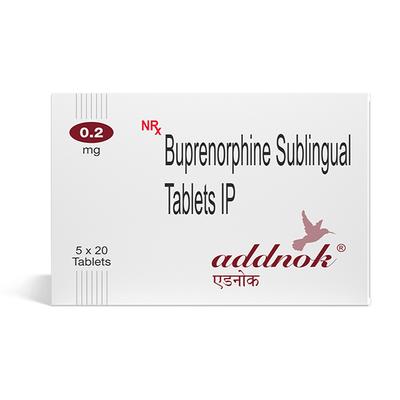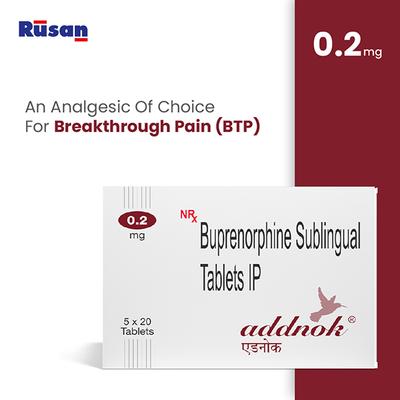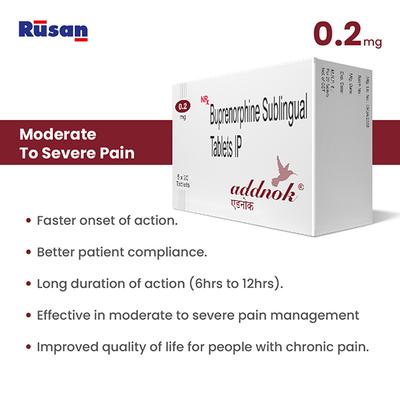

Netmeds First Membership
Quick Links
Introduction About ADDNOK TABLET
ADDNOK TABLET contains Buprenorphine which belongs to the group of medicines called Opioid Analgesics. It is used to provide relief from moderate or severe pain in affected individuals.
Pain is an uncomfortable sensation in the body that stems from the activation of nervous system which generally occurs as an annoying or debilitating sensation characterized by symptoms such as sharp, dull, throbbing, pinching, stinging, and/or burning sensation in affected individuals.
It is not recommended for use if you are allergic to buprenorphine or other opiates (having morphine-like action). Before taking ADDNOK TABLET, inform your doctor if you have breathing problems, liver problems, renal impairment, seizures (fits) and intolerance to certain sugars (such as lactose).
Opioids can lead to addiction, particularly when used for a long period of time and it may cause withdrawal symptoms (such as restlessness, difficulty sleeping, irritability, agitation, palpitation, etc.) when stop taking this medicine suddenly.
ADDNOK TABLET is not recommended for use in pregnant and breastfeeding women, including infants and children (under 6 years of age). It should be used with caution in elderly patients. Consult your doctor before taking ADDNOK TABLET.
The common side effects associated with the use of ADDNOK TABLET are constipation, headache, nausea, urinary retention and sedation. Consult your doctor if any of these side effects worsen.
Uses Of ADDNOK TABLET
- Provides relief from moderate to severe pain
How ADDNOK TABLET Works
ADDNOK TABLET works by blocking certain receptors (responsible for pain) in the brain and spinal cord which leads to blockage of pain transmission thus providing relief from moderate/severe pain in affected individuals.
How to use ADDNOK TABLET
Take ADDNOK TABLET as advised by your physician. Place the medicine beneath the tongue and let it dissolve. Do not crush, chew or swallow the medicine. Your doctor will decide the correct dose and duration for you depending on your age, body weight and disease condition. Do not take more ADDNOK TABLET without the advice of your doctor.
Side Effects Of ADDNOK TABLET
Common
- constipation
- headache
- nausea
- urinary retention
- sedation
Rare
Stop taking ADDNOK TABLET and contact your doctor immediately if you experience any of the following side effects:
- signs of an allergic reaction (such as sudden wheeziness, difficulty breathing, swelling in the eyelids, face, lips, rash, and/or itching)
- signs of respiratory depression such as breathing more slowly or weakly
- signs of low blood pressure such as feeling faint
How To Manage Side Effects
Constipation:
Try to eat more high-fibre foods such as fresh fruit, vegetables, cereals and drink plenty of water. Try doing exercise regularly (going for a daily walk). If this does not help, inform your doctor for receiving alternate management for constipation.
Headache:
Take rest and drink plenty of water. Avoid taking alcohol and skipping meals. Do not strain your eyes by watching the screen for a long time. Consult your doctor if the symptom persists for a long or gets worsens.
Nausea:
Stick to simple meals while taking this medicine. Avoid eating oily rich, fried or spicy foods. Do not lie down or sleep immediately after eating. Consult your doctor if the symptom does not improve.
Warning & Precautions
Pregnancy
ADDNOK TABLET is not generally recommended for use during pregnancy or in women planning for pregnancy unless it is considered clearly necessary. Consult your doctor before taking ADDNOK TABLET.
Breastfeeding
ADDNOK TABLET is not recommended for use in breastfeeding women as it passes through breast milk. Consult your doctor taking ADDNOK TABLET.
Driving and Using Machines
Do not drive or operate any machines if you feel drowsy, sleepy or dizzy after taking ADDNOK TABLET.
Alcohol
Avoid consumption of alcohol while taking ADDNOK TABLET because it may cause drowsiness. It should be used with caution in patients with a history of alcohol withdrawal symptoms (such as agitation, anxiety, shaking, and/or sweating) and also in patients who are addicted to alcohol. Consult doctor before taking ADDNOK TABLET.
Liver
ADDNOK TABLET should be used with caution in patients with liver problems. Consult your doctor before taking ADDNOK TABLET.
Allergy
Do not take ADDNOK TABLET if you are allergic to Buprenorphine, other opiates (having morphine like action) or any other ingredients of this medicine. Consult your doctor before taking the medicine.
Lungs
ADDNOK TABLET should be used with caution in patients with breathing problems. Consult your doctor before taking ADDNOK TABLET.
Others
Before taking ADDNOK TABLET, inform your doctor if you:
- have seizures, fits or convulsions
- are or were addicted to opioids, prescription medicines or illegal drugs
- require more medicine to get the same level of pain relief or get addicted to the medicine
- have depression or other conditions that are managed with antidepressants
- are intolerant to certain sugars (such as lactose)
Use in pediatrics:
ADDNOK TABLET is not recommended for use in infants and children (below 6 years of age). Your child’s doctor will prescribe the right dose depending on your child’s age, body weight and condition (between 6 to 12 years of age). Consult your child’s doctor for advice.
Use in geriatrics:
ADDNOK TABLET should be used with caution in elderly patients. Consult your doctor before taking ADDNOK TABLET.
Interactions
A. Drug-Drug Interactions
Before taking ADDNOK TABLET, inform your doctor, if you are taking any of the following medicines:
- medicines containing gestodene (a hormone used as a birth control pill in women)
- antibiotics (medicines used to manage infections) Ex. troleandomycin, rifampicin
- medicines used to manage fungal infections (Ex. ketoconazole)
- medicines used to manage depression (Ex. norfluoxetine, moclobemide, citalopram, escitalopram, fluoxetine, fluvoxamine, paroxetine, sertraline, duloxetine, venlafaxine, amitriptyline, doxepin, trimipramine) and monoamine oxidase inhibitors such as tranylcypromine, phenelzine and moclobemide
- medicines used to manage HIV infection such as protease inhibitors (Ex. ritonavir, indinavir and saquinavir)
- medicines used for epilepsy (Ex. carbamazepine, phenytoin, phenobarbital)
- other opioids (medicines used to manage pain/cough) Ex. morphine, dextropropoxyphene, codeine, dextromethorphan, noscapine
- medicines used to induce sleep such as tranquilisers (Ex. alprazolam), hypnotic/ sedatives (Ex. zolpidem)
Overdosage:
If you or anyone else accidentally takes too much of ADDNOK TABLET, consult your doctor immediately or visit the nearby hospital.
Synopsis
| Drug | : | Buprenorphine |
| Pharmacological Category | : | Opioid Analgesics |
| Therapeutic Indication | : | Moderate to severe pain |
| Dosage Forms | : | Tablet, Transdermal Patch, Injection |
More Information
- Keep the medicine out of reach of children
- Store ADDNOK TABLET at room temperature
FAQs About ADDNOK TABLET
What is ADDNOK TABLET used for?
ADDNOK TABLET is used to provide relief from moderate to severe pain in affected individuals which is an uncomfortable sensation in the body that stems from the activation of the nervous system, generally occurring as an annoying/debilitating sensation characterized by symptoms such as a sharp, dull, throbbing, pinching, stinging, and/or burning sensation in affected individuals.
What are the common side effects of ADDNOK TABLET?
The common side effects associated with the use of ADDNOK TABLET are constipation, headache, nausea, urinary retention and sedation. Consult your doctor if any of these side effects worsen.
Who should avoid taking ADDNOK TABLET?
ADDNOK TABLET is not recommended for use in patients who are allergic to buprenorphine. It is also not recommended for use in pregnant and breastfeeding women, including infants and children (aged below 6 years of age). Consult your doctor before taking ADDNOK TABLET.
How does ADDNOK TABLET work?
ADDNOK TABLET works by blocking certain receptors (responsible for pain) in the brain and spinal cord which leads to blockage of pain transmission thus providing relief from moderate/severe pain in affected individuals.
Does ADDNOK TABLET cause addiction?
ADDNOK TABLET leads to addiction particularly when used for long periods of time. Addiction can cause withdrawal symptoms when you stop taking this medicine suddenly. Your doctor may safely use this medicine by determining the management's duration and deciding when to stop prescribing this medicine for you.
Can alcohol be consumed while taking ADDNOK TABLET?
No, avoid consumption of alcohol while taking ADDNOK TABLET because it may cause drowsiness. It should be used with caution in patients with a history of alcohol withdrawal symptoms (such as agitation, anxiety, shaking, and/or sweating) and also in patients who are addicted to alcohol. Consult doctor before taking ADDNOK TABLET.
References
1. KD. Tripathi. Opioid Analgesics and Antagonists. Essentials of medical pharmacology. Seventh edition. 2013. Page 482.
2. C W Hand, J W Sear, J Uppington, M J Ball, H J McQuay, R A Moore. Buprenorphine disposition in patients with renal impairment: single and continuous dosing, with special reference to metabolites. NIH National Library of Medicine. National Center for Biotechnology Information. PubMed.gov. [Revised in March 1990] [Accessed on 12th September 2022] https://pubmed.ncbi.nlm.nih.gov/2328175/
3. Nalini Vadivelu, Roberta L Hines. Management of chronic pain in the elderly: focus on transdermal buprenorphine. NIH National Library of Medicine. National Center for Biotechnology Information. PMC PubMed Central. September 2008. [Accessed on 12th September 2022] https://www.ncbi.nlm.nih.gov/pmc/articles/PMC2682375/
4. Reckitt Benckiser Healthcare (UK) Limited. Electronic Medicines Compendium (EMC). [Revised in November 2020] [Accessed on 12th September 2022] https://www.medicines.org.uk/emc/files/pil.1142.pdf









